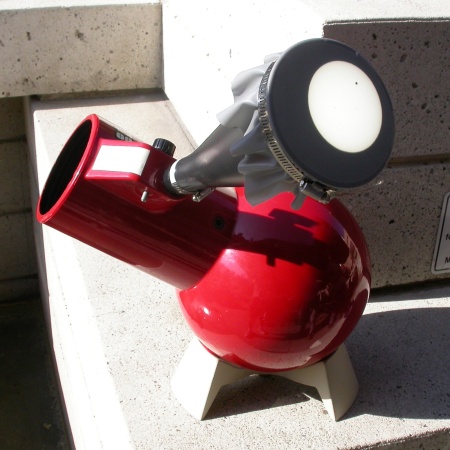Not a ton to say about this other than that we saw it. London was home from school for Veteran’s Day. It was sunny, warm, and bright, and neither of us fancied spending a ton of time standing in the sun, so we limited ourselves to a few quick peeks rather than continuous observation.
About the only notable thing about the transit was our observing rig, which is probably the redneckest job I ever threw together. Most of my good gear was packed away at the back of the garage and I didn’t fancy digging it out, so I taped a pair of cardboard eclipse glasses over the front of the SkyScanner 100 to create a subaperture mask, taped some spare cardboard from a torn-up Amazon box over that to block all the filter-less areas, and set the whole rig on our green-waste bin. It was decidedly low-tech, but not as sketchy as it sounds–I taped everything very securely to the tube so none of it could fall off, because the risk of direct, unfiltered sunlight through a scope is nothing to joke about. Then London and I took turns shading each other’s faces so we wouldn’t be squinting against the sun while we observed.
I didn’t take any pictures, we just watched the crisp little BB of Mercury drift across the face of the sun. The “lenses” of the solar glasses are about an inch in diameter, so basically we turned the 100mm f/4 system into a 25mm f/16 system, and a light cone that long is pretty forgiving. Which reminds me, I’ve just been reading about people experiencing a pseudo-3D “marble” effect when viewing the moon through telescopes of 40mm aperture or less. I should make a 40mm aperture mask for my C80ED and see if I get that effect.
Anyway, thus ended the transits of the twenty-teens. I was fortunate to catch them all: the Venus transit on June 5, 2012 (observing report), one Mercury transit on May 9, 2016 (observing report), and this second Mercury transit on November 11, 2019. The next Mercury transits won’t be until the 2030s: November 13, 2032 (I’ll be 57), and November 7, 2039 (64). Then 2049 and 2052, 2062 and 2065, and 2078. I’ll be 103 if I make it to that last one. The next Venus transit won’t be until 2117, 142 years after my birth, so barring some kind of technological miracle I don’t reckon I’ll be seeing another. It was a privilege to see the one that I did.
Now transit season is over for a bit over a decade, so we’ll have to find other things to keep busy with. Fortunately the sky has much to offer. Stay tuned.


























